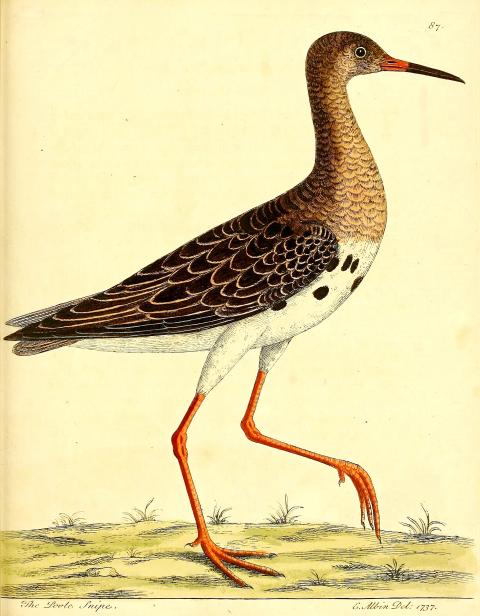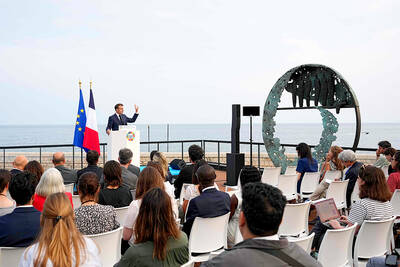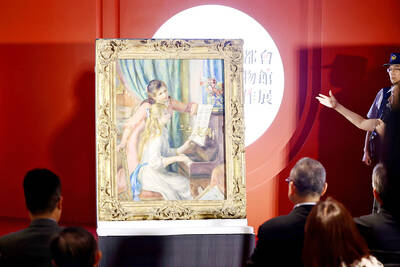Chinese practice
鷸蚌相爭,漁翁得利
(yu4 bang4 xiang1 zheng1 yu2 weng1 de2 li4)

Photo: Wikimedia Commons
照片:維基共享資源
When the sandpiper and the clam fight, the fisherman benefits.
一日天氣晴朗,有個漁夫沿著岸邊散步。他看到一隻鷸鳥,鳥的喙被夾在蚌殼中,於是就把鳥連同蚌殼一起抓走,都變成他的午餐。這情況原來是鷸鳥發現一隻蚌張開了殼正曬著太陽,就想把蚌肉啄出來吃。蚌就闔上了殼,把鳥喙給夾住了,鷸一慌,想要蚌放開,就嚇唬蚌說,今天不下雨,明天也不會下雨,如果你不放開的話就是死路一條。蚌反駁說,如果我不放開你,你也是死路一條。
就是在那時漁夫把它們都給抓住了。
這個故事是出自古中國經典《戰國策》中的〈魏策〉。代表燕國出使到趙國的策士蘇代,便是用這故事來勸阻趙惠文王攻打燕國。蘇代的論點是,如果趙國和燕國忙著互攻,那麼更強大的秦國就會趁此機會把兩國都摧毀——後來秦國也的確打敗了諸國而統一中國。
這故事便是成語「鷸蚌相爭,漁翁得利」的由來:其字面意思是,當鷸鳥和蚌互爭時,漁人便得到了利益。
許多歐洲語言中的說法也有類似的意義,例如十四世紀的英文諺語「while two dogs are fighting for a bone, a third runs away with it」(兩狗為爭一塊骨頭打架時,第三隻狗來搶走了骨頭),以及其他歐語的變形,像是德語「Wenn zwei sich streiten, freut sich der Dritte」(當雙方打架,第三方就高興了),以及羅馬尼亞語「Cand doi se cearta, al treilea castiga」(兩人為某事物爭鬥,第三方全贏)。
即使這英文諺語現今已很少使用,但有一個相關的說法「bone of contention」留傳了下來,它意指爭論的焦點,即一個不易解決的事物或問題。
(台北時報編譯林俐凱譯)
再內鬥下去只會落得兩敗俱傷,反倒讓敵國趁虛而入,坐收漁翁之利。
(If we keep fighting between ourselves we will both be weakened, and let the enemy take advantage of the situation. We will be benefitting them, not us.)
?這兩家公司競爭激烈,但是鷸蚌相爭,漁翁得利,結果都被更大的公司併購了。
(The competition between these two companies was really fierce, but it only served to help their rival, and they both ended up being bought out by a larger company.)
英文練習
bone of contention;
While two dogs are fighting for a bone, a third runs away with it.
A fisherman is walking along the shore on a sunny day. He sees a sandpiper with its beak stuck in a clam’s shell, and snatches them up for his lunch. It turns out, the sandpiper had caught the clam sunning itself, and tried to peck it out of its shell. The clam shut its shell around the bird’s beak, and the sandpiper, alarmed, attempted to scare the clam into releasing it, saying, it’s not going to rain today; it’s not going to rain tomorrow, either. You’ll be dead by then if you don’t open up. The clam retorted with, if I don’t set you free, then so will you.
That is when the fisherman grabbed them.
This story was related in the Strategies of Yan section of the ancient Chinese classic the Strategies of the Warring States. The military strategist Su Dai had traveled to Zhao to speak with King Huiwen on behalf of Yan, to dissuade him from attacking the state. Su’s point was that if Zhao and Yan were preoccupied with fighting each other, the more powerful state of Qin — which would, indeed, later defeat all of the states to unify China — would take advantage of the situation and destroy them both.
The story gives us the idiom 鷸蚌相爭,漁翁得利: literally, when the sandpiper and the clam fight, the fisherman benefits.
There is a similar sentiment to be found in many European languages, for example with the 14th century English proverb “while two dogs are fighting for a bone, a third runs away with it” and variations in other languages, including Wenn zwei sich streiten, freut sich der Dritte (German: When two fight, a third rejoices) and Cand doi se cearta, al treilea castiga (Romanian: where two people are fighting over something, the third party wins all).
Even though the English proverb is little used today, a related idea does survive: the “bone of contention,“ meaning an object or issue over which there is a disagreement that is not easily resolved.
(Paul Cooper, Taipei Times)
I wouldn’t mention who is going to inherit the old clock if I were you: It’s a bit of a bone of contention in our household.
(換做是我,我不會提誰來繼承這個古董時鐘。這在我們家是敏感問題,很容易引爆。)
Can’t we just sit down and discuss this? Why does it have to be such a bone of contention?
(我們難道不能坐下來好好談嗎?為什麼我們老是為這事爭論不休?)

William I of Prussia, a passionate painter, often autographed his works with “tormentis pinxit” — “painted in pain” — as a nod to his struggles with gout. Other historical figures like King Henry VIII of England and Benjamin Franklin also suffered from this “disease of kings,” which was common among people indulging in luxurious diets. Gout is primarily caused by high levels of uric acid in the body. Uric acid forms as the body breaks down purines, which are found in foods like red meat and seafood. Normally, the kidneys filter out uric acid. However, if the body produces

The UN Ocean Conference wrapped up in Nice, France on Friday last week with world leaders taking major steps toward marine protection and vowing a showdown when nations meet to negotiate rules for deep-sea mining next month. But a lack of funding pledges and the total omission of fossil fuels disappointed some observers. The summit was just the third — and largest yet — dedicated entirely to what the United Nations calls an “emergency” in the world’s oceans. The High Seas Treaty, or Global Ocean Treaty, is also known as the Agreement under the United Nations Convention on the Law

A: The National Palace Museum (NPM) has launched an exhibition, titled “From Impressionism to Early Modernism.” There are 81 masterpieces from the Metropolitan Museum of Art on display now. B: The exhibit, held to celebrate the NPM’s centennial, must be so spectacular. A: It includes artworks by 38 artists, such as Renoir, van Gogh, Cezanne, Matisse and Gauguin. B: The Fubon Art Museum has also launched an exhibit featuring a number of artworks of Impressionism, including Monet’s “Water Lilies.” A: And the New Taipei City Art Museum just had its grand opening, so there are even more exhibitions

A: What exhibitions are you going to see this summer? B: The 100% Doraemon & Friends exhibit is set to open on June 28. A: The news says there will be a 12-meter-tall giant Doraemon model at the Huashan 1914 Creative Park. B: The One Piece Carnival will set sail on the same day. A: And the D’festa Taipei 2025 – featuring exclusive content from K-pop supergroups such as BTS, NCT and Twice – is also set to begin next Friday. Isn’t that cool? A: 今年夏天還有什麼展覽可看啊? B: 「100%哆啦A夢 & Friends特展」即將在6月28日開幕。 A: 新聞說在華山1914文創園區會場,還有12米高的巨型哆啦A夢呢! B: 航海王「One Piece歡樂派對嘉年華」也將在同日啟航。 A: